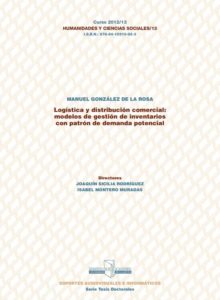Abdul, I. y Murata, A. (2011). An inventory model for deteriorating items with varying demand pattern and unknown time horizon. International Journal of Industrial Engineering Computations, 2, pp. 61 – 86. Ackoff, R. y Sasieni, M. (1971). Fundamentos de Investigación de Operaciones. Limusa-Wiley. México. Aggarwal, S.P. (1978). A note on an order-level inventory model for a system with constant rate of deterioration. Opsearch, 15, pp. 184 – 187. American Marketing Association (1985). Marketing News, 19 (5). American Marketing Association (2008). Dictionary of Marketing Terms. Anaya Tejero, J.J. (2011). Logística integral. La gestión operativa de la empresa. ESIC. Madrid. Antier, P. (1969). Manual práctico de la gestión de stocks. Ibérico Europea. Madrid. Arbones, E. (1992). Logística empresarial. Marcombo. Barcelona. Bahari-Kashani H. (1989). Replenishment schedule for deteriorating items with time-proportional demand. Journal of the Operational Research Society, 40 (1), pp. 75 – 81. Baker, R.C. y Urban, T.L. (1988a). A deterministic inventory system with an inventory-level-dependent demand rate. Journal of the Operational Research Society, 39, pp. 823 – 831. Baker, R.C. y Urban. T.L. (1988b). Single-period inventory dependent demand models. Omega, 16, pp. 605 – 607. Balkhi, Z.T. y Benkherouf, L. (2004). On an inventory model for deteriorating items with stock dependent and time-varying demand rates. Computer and Operations Research, 31, pp. 223 – 240. 209 Balkhi, Z.T. y Tadj L. (2008). A generalized economic order quantity model with deteriorating items and time varying demand, deterioration and costs. International Transactions in Operational Research, 15, pp. 509 – 517. Ballou, R.H. (1991). Logística empresarial, control y planificación. Díaz de Santos. Madrid. Ballou, R.H. (2004). Logística. Administración de la cadena de suministro. Pearson Educación. Prentice-Hall. México. Barbosa, L.C. y Friedman, M. (1978). Deterministic inventory lot size models – a general root law. Management Science, 24, pp. 819 – 826. Bello, L., Vázquez R. y Trespalacios J.A. (1993). Investigación de mercados y estrategias de marketing. Civitas. Madrid. Bose, S., Goswami, A. y Chauddhuri, K.S. (1995). An EOQ model for deteriorating items with linear time-dependent demand rate and shortages under inflation and time discounting. Journal of the Operational Research Society, 46, pp. 771 – 782. Bowersox, D.J. (1974). Logistical Management: a systems integration of physical distribution management, material management, and logistical coordination. New York: Macmillan Publishing Co. Bowersox, D.J., Closs, D.J. y Bixby, M. (2006). Supply chain logistics management. McGraw-Hill. Irwin. New York. Bowersox, D.J., Closs, D.J. y Stank, T.P. (2000). Ten mega-trends that will revolutionize supply chain logistics. Journal of Business Logistics, 2 (2), pp. 1 – 16. Bueno, E., Cruz, I. y Durán, J. J. (1996). Economía de la Empresa. Análisis de las decisiones empresariales. Pirámide. Madrid. Cárdenas-Barrón, L.E. (2008). Optimal manufacturing batch size with rework in a single-stage production system-a simple derivation. Computers and Industrial Engineering, 55, pp. 758 – 765. 210 Cárdenas-Barrón, L.E. (2009a). On optimal batch sizing in a multi-stage production system with rework consideration. European Journal of Operational Research, 196, pp. 1238 – 1244. Cárdenas-Barrón, L.E. (2009b). Economic production quantity with rework process at a single-stage manufacturing system with planned backorders. Computers and Industrial Engineering, 57, pp. 1105 – 1113. Carrallo, A. (1978). Logística comercial. ESIC. Madrid. Casanovas, A. y Cuatrecasas, L. (2001). Logística Empresarial. Gestión 2000. Barcelona. Casares, J. (2003). El nuevo paisaje del consumo. Distribución y Consumo, 70, pp. 5 – 10. Casares, J. y Martín, V. (2003). Evolución de la distribución comercial y de los hábitos de compra: del dualismo al poliformismo. Información Comercial Española. Revista de Economía, 811, pp. 323 – 347. Casares, J., Pablo, A., Muñoz, P. y Rebollo A. (1990). La distribución comercial en España. Papeles de Economía Española, 42, pp. 251 – 261 Casares, J. y Rebollo, A. (2005). Distribución comercial. Thomson-Civitas. Madrid. Castán, J.M., Cabañero, C. y Nuñez, A. (2000). La logística en la empresa. Pirámide. Madrid. Castañeda, J. (1979). Lecciones de Teoría Económica. Aguilar. Madrid. Chang H.J. y Dye, C. Y. (1999). An EOQ model for deteriorating items with time varying demand and partial backlogging. Journal of the Operational Research Society, 50 (11), pp. 1176 – 1182. Chang, C.T., Goyal, S.K. y Teng, J.T. (2006). On an EOQ model for perishable items under stockdependent selling rate and time-dependent partial backlogging by Dye and Ouyang. European Journal of Operational Research, 174, pp. 923 – 929. Chang, C.T., Teng, J.T. y Goyal, S.K. (2010). Optimal replenishment policies for non-instantaneous deteriorating items with stock-dependent demand. International Journal of Production Economics, 123, pp. 62 – 68. 211 Chase, R.B. y Aquilano, N.J. (1994). Dirección y administración de la producción y las operaciones. Addison-Wesley Iberoamericana. México. Chern, M.S., Yang, H.L., Teng, J.T. y Papachristos, S. (2008). Partial backlogging inventory lot-size models for deteriorating items with fluctuating demand under inflation. European Journal of Operational Research, 191, pp. 127 – 141. Christopher, M. (1994). Logística y aprovisionamiento. Folio. Barcelona. Chung, K.J. (2003). An algorithm for an inventory model with inventory-level-dependent demand rate. Computers and Operations Research, 30, pp. 1311 – 1317. Colerus, E. (1972). Breve historia de las matemáticas. Altamira, 1 y 2. Madrid. Council of Logistics Management (1998). What It´s About. Illinois: Oak Brook, IL. Cruz Roche, I. (1991). Fundamentos de Marketing. Ariel. Madrid. Cuatrecasas, L. (1999). Gestión de stocks y las necesidades de materiales. Gestión 2000. Barcelona. Cuatrecasas, L. (2000). Organización de la producción y dirección de operaciones. Sistemas actuales de gestión eficiente y competitiva. Centro de Estudios Ramón Areces. Madrid. Datta, T.K. y Pal, A.K. (1988). Order level inventory system with power demand pattern for items with variable rate of deterioration. Indian Journal of Pure and Applied Mathematics, 19, pp. 1043 – 1053. Datta, T.K. y Pal, A.K. (1990). A note on an inventory model with inventory-level-dependent demand rate. Journal of the Operational Research Society, 41, pp. 971 – 975. Datta, T.K. y Pal, A.K. (1992). A note on a replenishment policy for an inventory model with linear trend in demand and shortages. Journal of the Operational Research Society, 43, pp. 993-1001. 212 Dave, U. (1989). On a heuristic inventory replenishment rule for items with linearly increasing demand incorporating shortages. Journal of Operational Research Society, 40, pp. 827 – 830. Dave, U. y Patel, R.K. (1981). (T,Si) policy inventory model for deteriorating items with time proportional demand. Journal of the Operational Research Society, 32, pp. 137 – 142. Dawson, J. y Frasquet, M. (2006). Factores determinantes del nuevo papel de la distribución minorista en Europa. Información Comercial Española, 828, pp. 11 – 34. Deb, M. y Chaudhari, K. (1987). A note on the heuristic for replenishment of trended inventories considering shortages. Journal of Operational Research Society, 38, pp. 459 – 463. Debreu, G. (1991). The mathematization of economic theory. American Economic Review, 81, pp. 1 – 7. De Juan Vigaray, M.D. (2005). Comercialización y retailing. Distribución comercial aplicada. Pearson Educación. Prentice Hall. Madrid. Deng, P.S., Yen, C.P., Tung, C.T., Yu, Y.C. y Chu, P. (2006). A technical note for the deteriorating inventory model with exponential time-varying demand and partial backlogging. International Journal of Information and Management Sciences, 17, pp. 101 – 108. Deng, P.S., Lin, R.H.J. y Chu. P. (2007). A note on the inventory models for deteriorating items with ramp type demand rate. European Journal of Operational Research, 178, pp. 112 – 120. Díez de Castro, E.C. (1992). Logística comercial. Editorial McGraw-Hill. Madrid. Díez de Castro, E.C. y Fernández, J. C. (1993). Distribución comercial. McGraw-Hill. Madrid. Díez de Castro, E.C. (1997). Distribución comercial. McGraw-Hill. Madrid. Domínguez Machuca, J.A., García, S., Ruiz, A. y Álvarez Gil, M.J. (1995). Dirección de operaciones: aspectos estratégicos. McGraw-Hill. Madrid. 213 Donaldson, W.A. (1977). Inventory replenishment policy for a linear trend in demand: an analytic solution. Operational Research Quarterly, 28, pp. 663 – 670. Dye, C.Y. (2004). A note on an EOQ model for items with Weibull distributed deterioration, shortages and power demand pattern. International Journal of Information and Management Sciences, 15, pp. 81 – 84. Dye, C.Y. y Ouyang, L.Y. (2005). An EOQ model for perishable items under stock-dependent selling rate and time-dependent partial backlogging. European Journal of Operational Research, 163, pp. 776 – 783. Dye, C.Y., Ouyang, L.Y. y Hsieh, T.P. (2008). A note on EOQ models for perishable items under stock dependent selling rate. Information and Management Sciences, 19, pp. 519 – 534. Esteban Talaya A, García de Madariaga, J., Narros, M.J., Olarte, C., Reinares, E.M. y Saco, M. (2008). Principios de marketing. ESIC. Madrid. Eppen, G.D. y Gould E.J. (2000). Investigación de Operaciones en la Ciencia Administrativa. PrenticeHall Hispanoamericana. México. Fernández, A, Martínez, E. y Rebollo, A. (2007). La reorganización de los canales de comercialización. Nuevos enfoques del marketing y la creación de valor. Mediterráneo Económico, Colección de Estudios Socioeconómicos, Cajamar, 11, pp. 195 – 210. Fernández, A., Martínez, E. y Rebollo, A. (2008). Tendencias de evolución de la distribución comercial en España. Distribución y Consumo, 101, pp. 5 – 17. Fernández Pirla, J. M. (1981). Economía y gestión de la empresa. ICE. Madrid. Flavian C., Martinez E. y Polo Y. (1997). La distribución comercial en España: evolución reciente y perspectivas de futuro. Boletín ICE Económico, 2558, pp. 17 – 28. Ghare, P.M. y Schrader, G.F. (1963). A model for an exponential decaying inventory. Journal Industrial Engineering, 14, pp. 238 – 243. 214 Ganeshan, R. y Harrison, T. P. (1995). An introduction to supply chain management. Department of Management Science and Information Systems. Penn Estate University. USA. García Echevarría, S. (1975). Introducción a la Economía de la Empresa. Libros de lectura. CECA. Madrid. García Sabater, J.P., Cardós, M., Albarracín, G. y García Sabater, J.J. (2005). Gestión de stocks de demanda independiente. Universidad Politécnica de Valencia (UPV). Valencia. Ghosh, S.K. y Chaudhuri, K.S. (2005). An EOQ model for a deteriorating item with trended demand and variable backlogging with shortages in all cycles. Advanced Modelling and Optimization, 7, pp. 57 – 68. Giri, B.C., Goswami, A. y Chaudhuri, K.S. (1996). An EOQ model for deteriorating items with time varying demand and costs. Journal of the Operational Research Society, 47, pp. 1398 – 1405. Gómez, M. y Acevedo, J.A. (2000). Logística del aprovisionamiento. Corporación John F. Kennedy. Bogotá. Goel, V.P. y Aggarwal, S. P. (1981). Order level inventory system with power demand pattern for deteriorating items. Proceedings of the All India Seminar on Operational Research and Decision Making, University of Delhi, New Delhi, pp. 19 – 34. Goswami, A. y Chaudhuri, K.S. (1991). EOQ model for an inventory with a linear trend in demand and finite rate of replenishment considering shortages. International Journal of Systems Science, 22, pp. 181 – 187. Goyal, S.K., Morin, D. y Nebebe, F. (1992). The finite horizon trended inventory replenishment problem with shortages. Journal of Operational Research Society, 43, pp. 1173 – 1178. Goyal, S.K. y Giri, B.C. (2001). Recent trends in modeling of deteriorating inventory. European Journal of Operational Research, 134, pp. 1 – 16. Gutemberg, E. (1973). Economía de la Empresa. Teoría y práctica de la gestión empresarial. Deusto. Bilbao. 215 Gutierrez, G. y Prida, B. (1998). Logística y distribución fisica. McGraw-Hill. Madrid. Hadley, G. y Whitin, T.M. (1963). Analysis of inventory systems. Prentice-Hall. New Jersey. Harris, F. W. (1913a). How many parts to make at once. Factory, The Magazine of Management, 10, 135 – 136, 152. Harris, F. W. (1913b). How much stock to keep on hand. Factory, The Magazine of Management, 10, 240 – 241, 281 – 284. Hillier, F. S. y Lieberman, G.J. (2006). Investigación de Operaciones. McGraw-Hill. México. Hollier, R.H. y Mak, K.L. (1983). Inventory replenishment policies for deteriorating items in a declining market. International Journal of Production Research, 21, pp. 813 – 826. Hopp, W. J. (2004). Supply chain science. McGraw-Hill. New York. USA. Hsu, P.H., Teng, H.M., y Wee, H.M. (2009). Optimal lot sizing for deteriorating items with triangleshaped demand and uncertain lead time. European Journal of Industrial Engineering, 3, pp. 247 – 260. Hung, K.C. (2011). An inventory model with generalized type demand, deterioration and backorder rates. European Journal of Operational Research, 208, pp. 239 – 242. Jaggi, C.K., Aggarwal, K.K. y Goel, S.K. (2006). Optimal order policy for deteriorating items with inflation induced demand. International Journal of Production Economics, 103, pp. 707 – 714. Jeong I-J. (2011). A dynamic model for the optimization of decoupling point and production planning in a supply chain. International Journal of Production Economics, 131 (2), pp. 561 – 567. Jolai, F., Tavakkoli-Moghaddam, R., Rabbani, M. y Sadoughian, M.R. (2006). An economic production lot size model with deteriorating items, stock-dependent demand, inflation, and partial backlogging. Applied Mathematics and Computation, 181, pp. 380 – 389. 216 Kent, J.L. y Flint, D.J. (1997). Perspectives on the evolution of logistic thought. Journal of Business Logistics, 18 (2), pp. 15 – 29. Khmelnitsky, E. y Gerchak, Y. (2002). Optimal control approach to production systems with inventorylevel-dependent demand. IEEE Transactions on Automatic Control, 47, pp. 289 – 292. Kotler, P., Cámara, D., Grande, I. y Cruz I. (1995). Dirección de marketing. Análisis, planificación, implementación y control. Pearson Educación. Prentice-Hall. Madrid. Kotler, P., Cámara, D., Grande, I. y Cruz I. (2000). Dirección de marketing. Edición del milenio. Pearson Educación. Prentice-Hall. Madrid. Kotler, P. y Amstrong, G. (2003). Fundamentos de marketing. Pearson Educación. Prentice-Hall. México. Kotler, P., Lane, K., Cámara, D. y Mollá, A. (2006). Dirección de marketing. Pearson Educación. Prentice-Hall. Madrid. Lambert, D.M., Stock, J.R. y Ellram, L.M. (1998). Fundamentals of logistics management. McGrawHill. New York. Lambin, J. J. (1993). Marketing estratégico. McGraw-Hill Iberoamericana. México. Lee, W.C. y Wu, J.W. (2002). An EOQ model for items with Weibull distributed deterioration, shortages and power demand pattern. International Journal of Information and Management Sciences, 13, pp. 19 – 34. Lee, W.C. y Wu, J.W. (2004). A note on EOQ model for items with mixtures of exponential distribution deterioration, shortages and time-varying demand. Quality and Quantity, 38, pp. 457 – 473. Levy, D.L. (1997). Lean production in an international supply chain. Sloan Management Review, 38 (2), pp. 94 – 101. Li, R., Lan, H. y Mawhinney, J.R. (2010). A review on deteriorating inventory study. Journal of Service Science and Management, 3, pp. 117 – 129. 217 Libro Verde del Comercio (1996). Libro Verde del Comercio. Comisión Europea. Bruselas. Libro Blanco del Comercio (1996). Libro Blanco del Comercio. Comisión Europea. Bruselas. Liao, J.J. y Huang, K.N. (2010). Deterministic inventory model for deteriorating items with trade credit financing and capacity constraints. Computers and Industrial Engineering, 59, pp. 611 – 618. Lin, G.C., Kroll, D.E. y Lin, C.J. (2006). Determining a common production cycle time for an economic lot scheduling problem with deteriorating items. European Journal of Operational Research, 173, pp. 669 – 682. Lin Y. y Lin C. (2006). Purchasing model for deteriorating items with time-varying demand under inflation and time discounting. International Journal Advanced Manufacturing Technology, 27, pp. 816 – 823. Maihami, R. y Kamalabadi, I.N. (2012). Joint pricing and inventory control for non-instantaneous deteriorating items with partial backlogging and time price dependent demand. International Journal of Production Economics, 136 (1), pp. 116 – 122. Magee, J. F., Copacino, W. C. y Rosenfield, D.B. (1973). Modern logistics management. John Wiley and Sons. New York. Martin Armario, E. (1993). Marketing. Ariel Economía. Barcelona. Martínez. F.J. y Maraver, G. (2009). Distribución comercial. Delta. Madrid. Mathur, K. y Solow, D. (1996). Investigación de Operaciones. El arte de la toma de decisiones. Prentice Hall. México. Mehta, N.J. y Shah, N.H. (2003). An inventory model for deteriorating items with exponentially increasing demand and shortages under inflation and time discounting. Investigação Operacional, 23, pp. 103 – 111. 218 Mentzer, J.T., Flint, D.J. y Hult, T.M. (2001). Logistics service quality as a segment-customized process. Journal of Marketing, 65(4), 82 – 104. Mentzer, J.T., Min, S. y Bobbitt, L.M. (2004). Toward a unified theory of logistics. International Journal of Physical Distribution and Logistics Management, 34 (8), pp. 606 – 627. Miller, D. y Starr, M.K. (1960). Executive decisions and Operations Research. Prentice-Hall. Englewood Cliffs. New York. Miquel Peris, S., Bigne, E. y Molla, A. (1995). Introducción al marketing. McGraw-Hill. Madrid. Miquel Peris, S, Parra Guerrero, F., Lhermie, C. y Miquel Romero, M. J. (2008). Distribución comercial. ESIC. Madrid. Miranda, F.J., Rubio, S., Chamorro, A. y Bañegil, T.M. (2005). Manual de dirección de operaciones. Thomson. Madrid. Misra, R.B. (1975). Optimum production lot-size model for a system with deteriorating inventory. International Journal of Production Research, 13, pp. 495 – 505. Mitra, A., Cox, J.F. y Jesse, R.R. (1984). A note on deteriorating order quantities which a linear trend in demand. Journal of the Operational Research Society, 35, pp. 141 – 144. Monks, J.G. (1994). Administración de operaciones. McGrall-Hill Interamericana. México. Montero, I. y Oreja, J.R. (1998). Las empresas de comercio interior en Canarias: diagnóstico y alternativas estratégicas. El comercio minorista en canarias. Consejería de Economía y Hacienda-Fyde Cajacanarias. IUDE, pp. 69 – 73. Moon, I., Giri, B.C. y Ko, B. (2005). Economic order quantity models for ameliorating/deteriorating items under inflation and time discounting. European Journal of Operational Research, 162, pp. 773 – 785. Naddor, E. (1966). Inventory Systems. John Wiley and Sons. New York. 219 Norbert, E. (1981). Gestión de stocks. Deusto. Bilbao. Oreja Rodríguez J.R. (1993). Organización de empresas: teorías y casos. IUDE. Serie docente nº 93.01. La Laguna. Tenerife. Park, T.A. y King, R.P. (2007). Evaluating retailing efficiency: the role of information technology. Journal of Productivity Analysis, 27, pp. 101 – 113. Parra Guerrero F. (2005). Gestión de stocks. ESIC. Madrid. Pau C. J. y Navascués, G. R. (2001). Manual de logística integral. Díaz de Santos. Madrid. Pentico, D.W. y Drake, M.J. (2009). The deterministic EOQ with partial backordering: a new approach. European Journal of Operational Research, 194, pp. 102 – 113. Prída, B. y Gutiérrez, C. G. (1995). Logística de aprovisionamiento: el cambio en las relaciones proveedor-clientes, un nuevo desafío para la empresa del siglo XXI. McGraw-Hill Interamericana de España. Madrid. Porter, M. E. (2002). Ventaja competitiva. CECSA. México. Prawda, J. (1991). Métodos y modelos de Investigación de Operaciones. I y II. Limusa. México. Raafat, F. (1991). Survey of literature on continuously deteriorating inventory model. Journal of the Operational Research Society, 42, pp. 27 – 37. Rajeswari, N. y Vanjikkodi, T. (2011). Deteriorating inventory model with power demand and partial backlogging. International Journal of Mathematical Archive, 2, pp. 1495 – 1501. Rambaux, A. (1988). Gestión económica de los stocks. Dunod. París. Rebollo, A. (1993). Clasificación de las formas comerciales: el producto-establecimiento. Distribución y Consumo, 10, pp. 10 – 18. 220 Rebollo, A. (1998). Factores de evolución en la distribución minorista. Distribución y Consumo, 42. Resh, M., Friedman, M., y Barbosa, L.C. (1976). On a general solution of the deterministic lot size problem with time-proportional demand. Operations Research, 24 (4), pp. 718 – 725. Rios, S. (1995). Modelización. Alianza Universidad. Madrid. Rios, S., Mateos, A., Bielza, M.C. y Jimenéz, A. (2004). Investigación Operativa. Modelos deterministas y estocásticos. Centro de Estudios Ramón Areces. Madrid. Ritchie, E. (1984). The EOQ for linear increasing demand: a simple optimal solution. Journal of the Operational Research Society, 35, pp. 949 – 952. Rodríguez Castellanos A., García Merino J.D. y Peña Cerezo, M.A (2005). La metodología científica en Economía de la Empresa en la actualidad. Universidad de Vigo. Investigaciones Europeas de Dirección y Economía de la Empresa, 11 (2), pp. 143 – 162. Roux, M. (2009). Manual de logística para la gestión de almacenes. Gestión 2000. Barcelona. Roychowdhury M. y Chaudhuri, K.S. (1983). An order level inventory model for deteriorating items with finite rate of replenishment. Opsearch, 20, pp. 99 – 106. Rufin, R. (2010). Marketing. UNED. Sanz y Torres. Madrid. Rushton, A. y Oxley, J. (1989). Handbook of logistics and distribution management. Kogan Page. Reino Unido. Sainz de Vicuña, J.M. (1996a). Comercio tradicional. Opciones estratégicas. Distribución y Consumo, 30, pp. 6 – 29. Sainz de Vicuña, J.M. (1996b). La distribución comercial: opciones estratégicas. Esic. Madrid. Samanta, G.P. y Roy, A. (2004). A deterministic inventory model of deteriorating items with two rates of production and shortages. Tamsui Oxford Journal of Mathematical Sciences, 20, pp. 205 – 218. 221 San José, L.A., Sicilia, J. y Garcia-Laguna, J. (2009). A general model for EOQ inventory systems with partial backlogging and linear shortage costs. International Journal of Systems Science, 40, 59 – 71. Sana, S.S. (2010). A production-inventory model in an imperfect production process. European Journal of Operational Research, 200, pp. 451 – 464. Santesmases, M. (1991). Marketing. Esic. Madrid. Santesmases, M. (2012). Marketing, conceptos y estrategias. Pirámide. Madrid. Sarabia, A. (1996). La Investigación Operativa. Una herramienta para la adopción de decisiones. UPCO. Madrid. Servera-Francés, D. (2010). Concepto y evolución de la función logística. Revista Innovar, 20 (38), pp. 217 – 234. Schroeder, R.G. (1992). Administración de Operaciones: toma de decisiones en la función de operaciones. McGraw-Hill Interamericana. México. Shah, N.H. (2009). Vendor’s optimal policy for time-dependent deteriorating inventory with exponentially decreasing demand and partial backlogging. ASOR Bulletin, 28, pp. 9 – 14. Shah, Y.K. y Jaiswal, M.C. (1977). An order-level inventory model for a system with constant rate of deterioration. Opsearch, 14, pp. 174 – 184. Shamblin, J.E. y Stevens, G.T. (1975). Investigación de Operaciones. McGraw-Hill. México. Silver, E.A. y Meal, H.C. (1973). A heuristic for selecting lot size quantities for the case of a deterministic time-varying demand rate and discrete opportunities for replenishment. Production and Inventory Management Journal, 14, pp. 64 – 74. Silver E. A., Pyke D.F. y Petersen R.P. (1998). Inventory management and production planning and scheduling. John Wiley. New York. Singh, T.J., Singh, S.R. y Dutt, R. (2009). An EOQ model for perishable items with power demand and 222 partial backordering. International Journal of Operations and Quantitative Management, 15, pp. 65 – 72. Skouri, K., Konstantaras, K., Papachristos, S. y Ganas, I. (2009). Inventory models with ramp type demand rate, partial backlogging and Weibull deterioration rate. European Journal of Operational Research, 192, pp. 79 – 92. Soldevilla, E. (1986). Fuentes y campos científicos de la Economía de la Empresa. Gestión Científica, UNED, 2 (1), pp. 5 – 26. Soldevilla, E. (1987a). Posicionamiento actual de la Economía de la Empresa. Revista de Economía y Empresa, 7 (17-18), pp. 13 – 19. Soldevilla, E. (1995). Metodología de investigación de la Economía de la Empresa. Investigaciones Europeas de Dirección y Economía de la Empresa, 1 (1), pp. 13 – 63. Soret los Santos, I. (1999). Logística y marketing para la distribución comercial. ESIC. Madrid. Stanton, W. (1985). Fundamentos de marketing. McGraw-Hill. México. Stoer, J. y Bulirsch, R. (2002). Introduction to numerical analysis. Springer-Verlag, New York. Taha, H.A. (2004). Investigación de Operaciones, una introducción. Prentice-Hall. México. Teng, J.T., Chern, M.S. y Yang, H.L. (1997). An optimal recursive method for various inventory replenishment models with increasing demand and shortage. Naval Research Logistics, 44, pp. 791 – 806. Teng, J.T. y Yang, H.L. (2004). Deterministic economic order quantity models with partial backlogging when demand and cost are fluctuating with time. Journal of the Operational Research Society, 55 (5), pp. 495 – 503. Teng, J.T., Yang, H.L., y Chern, M.S. (2011). Economic order quantity models for deteriorating items and partial backlogging when demand is quadratic in time. European Journal of Industrial Engineering, 5, pp. 198 – 214. 223 Tersine, R. J. (1988). Principles of inventory and materials management. New York: North-Holland. New York. Urban, T.L. (2005). Inventory models with inventory-level-dependent demand: a comprehensive review and unifying theory. European Journal of Operational Research Society, 162, pp. 792 – 804. Vázquez, R. y Trespalacios, J. (1997). Distribución comercial. Estrategias de fabricantes y detallistas. Civitas. Madrid. Vázquez, R. y Trespalacios, J. (2002). Marketing: estrategias y aplicaciones sectoriales. Civitas. Madrid. Vázquez, R. y Trespalacios, J. (2006). Estrategias de distribución comercial. Thomson. Madrid. Ventsel, E.S. (1983). Investigación de operaciones: problemas, principios, metodología. MIR. Moscú. Wagner, H.M. y Whitin, T. (1958). Dynamic version of the economic lot size model. Management Science, 5, pp. 89 – 96. Waters, C.D.J. (1992). Inventory Control and Management. John Wiley & Sons. Chichester. England. Waters, C.D.J. (2001). Inventory Management. En Brewer, et. al. (Eds). Handbook of Logistics and Supply Chain Management. Pergamon, Elsevier Science, Ltd. Whitin, T.M. (1957). Theory of inventory management. Princeton University Press. New York. Widyadana, G.A., Cárdenas-Barrón, L.E. y Wee, H.M. (2011). Economic order quantity model for deteriorating items with planned backorder level. Mathematical and Computer Modelling, 54, pp. 1569 – 1575. Wilson, R. H. (1934). A scientific routine for stock control. Harvard Bus, 13, pp. 116 – 128. Wu, K.S. (2002). Deterministic inventory model for items with time varying demand, Weibull distribution deterioration and shortages. Yugoslav Journal of Operations Research, 12, pp. 61 – 71. 224 Wu, K.S., Ouyang, L.Y. y Yang, C.T. (2006). An optimal replenishment policy for non-instantaneous deteriorating items with stock-dependent demand and partial backlogging. International Journal of Production Economics, 101, pp. 369 – 384. Yan, C., Banerjee, A. y Yang, L. (2011). An integrated production-distribution model for a deteriorating inventory item. International Journal of Production Economics, 133, pp. 228 – 232. Yang, C.T., Ouyang, L.Y., Wu, K.S. y Yen, H.F. (2011). An optimal replenishment policy for deteriorating items with stock-dependent demand and relaxed conditions under limited storage space. Central European Journal of Operations Research, 19, pp. 139 – 153. Zermati, P. (2004). Gestión de stocks. Pirámide. Madrid. Zipkin, P. H. (2000). Foundations of Inventory Management. McGraw-Hill. Singapore.

BIBLIOGRAFÍA
You May Also Like
More From Author
Cancelar la respuesta
Lo siento, debes estar conectado para publicar un comentario.






















+ There are no comments
Add yours